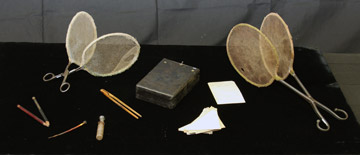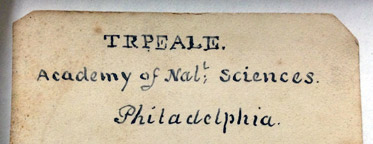
Titian Ramsay Peale's Insect Specimen Collection Kit
From left to right: pencil JEFF-8397, pencil JEFF-8390, net JEFF 7998, dissecting needle JEFF-8392, glass vial JEFF-8391, tweezers JEFF-8399, box JEFF-7997, paper specimen containers JEFF-8394, card with Titian Peale's name JEFF-8389, net JEFF-8400
January's artifact of the month is Titian Ramsay Peale's insect specimen collection kit. This kit was a vital tool of one of America's early naturalist explorers used in his efforts to document the native species of the American continent.
Titian Ramsay Peale (1799-1885) was one of early America's foremost naturalists and the successor to his father, Charles Willson Peale, running their famous museum in Philadelphia. Literally born in the family museum in Independence Hall, Titian was raised in a family of artists, honing his skills as an illustrator and naturalist as a very young man. As a child, he saw his father house and catalog specimens from the Lewis and Clark expedition. His first published illustrations appeared in Thomas Say's American Entomology in November 1817 when he was 17 years old. By the time Major Stephen Long selected Titian to be the naturalist illustrator for his scientific contingent of the Yellowstone Expedition in 1819, Titian was already the veteran of a scientific exploration of Georgia and Florida. (Haltman, Kenneth. Looking Close and Seeing Far, 117)
Long's expedition aimed to observe, report, collect, and catalog the wonders of the Great Plains for the American government and people. Naturalists on the east coast and in Europe had a great interest in the animals, insects, and plants unknown to them that inhabited the American west. Peale's official duties were "drafting and delineating botanical, zoological and geological specimens." (Haltman, xix) The expedition departed from St. Louis in June of 1819 and traveled on the steamboat The Western Engineer up the Missouri to winter near Council Bluffs, Iowa. Long then received orders to leave the Missouri, change course and explore the area of the Platte and Red Rivers. It was a dangerous trip and the party lost their way-exploring the wrong river. Many of the scientific notebooks and journals were lost when some members of the party deserted. (Goetzmann, William H. Exploration and Empire: The Explorer and the Scientist in the Winning of the American West, 58-61)

The insect collection kit dates from this expedition. The kit consists of a leather box which held: a glass vial, folded papers to store specimens, a dissecting needle, some wooden tweezers, a card labeled "Titian Ramsay Peale", and two pencils. Two insect collecting nets that look a bit like two tennis racquets hinged together called "forceps nets" or "flappers" were also part of his equipment. One of Peale's butterfly drawings contains an illustration of this type of net. "It was used for taking insects from foliage; the frames were closed upon the specimen, which was then transfixed with a pin inserted through the gauze." (Wilkinson, 103)
Peale was meticulous in documenting his sketches and detailed drawings with numbers to match them to the specimens captured in the field. (Haltman, 113) Today, his sketchbooks from the expedition are owned by Yale University Art Gallery. The drawings are housed at the American Philosophical Society. Here is a link to a drawing of a cicada, perhaps one Peale caught with this very kit!
After the expedition, Peale was the manager of the family museum. He joined the United States Exploring Expedition of 1838-1842 (the Wilkes Expedition) and traveled the world collecting specimens and drawing the plants, animals and insects found in Fiji, Hawaii, the Philippines and other Pacific locales.
Many of the actual butterflies and moths collected by Peale are still extant in Philadelphia at the Academy of Natural Sciences. Due to Peale's careful specimen preservation and the work of museum conservators over the last two centuries it is possible to see many of the actual creatures captured by Peale. They are still housed in the innovative booklike cases he designed and constructed, allowing the viewer to see both sides of the specimens. This amazing resource, one of the oldest natural history collections in America, was conserved and photographed by the Academy of Natural Sciences.
After the expedition, the Peale museum had financial difficulties and had to close in 1843. Peale went to work for the U.S. Patent Office and adopted a new medium, becoming one of the first well-known photographers in America.
This kit is a reminder of the spirit of American exploration and the enlightenment drive to catalog and organize nature for human understanding.
Goetzmann, William H. Exploration and Empire: The Explorer and the Scientist in the Winning of the American West. Austin: The Texas Historical Association, 1993.
Haltman, Kenneth. Looking Close and Seeing Far: Samuel Seymour, Titian Ramsay Peale and the Art of the Long Expedition. University Park: The Pennsylvania State University Press, 2008.
Lamar, Howard R., ed. "Titian Ramsay Peale", The New American Encyclopedia of the West. New Haven and London: Yale University Press, 1998.
Wilkinson, R.S. "Cover Photo: A Note About Nets", The Michigan Entomologist, Vol. 1, No. 3. December 1966.

